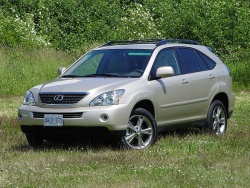 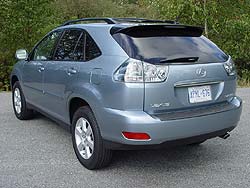 2006 Lexus RX 400h (top) and 2004 RX 330; photos by Greg Wilson. Click image to enlarge |
|
Related articles on Autos
Manufacturer’s web site
|
By Chris Chase
Discuss this story in the forum at CarTalkCanada
Photo Gallery:
2006 Lexus RX 400h
The Lexus RX started life as the Sport Luxury Vehicle Concept, which was first shown at the Chicago Auto Show in 1997; later that year, it went on sale in Japan as the Toyota Harrier. The RX went on sale in North America a few months later.
While its Camry-based underpinnings made it the brand’s first crossover SUV, the RX was not the first Lexus truck; that title goes to the bigger LX – based on the Toyota Land Cruiser – which debuted in 1996. The first RXs were badged RX300, and used Toyota’s 3.0-litre V6 engine and a four-speed automatic, with either front- or all-wheel drive.
A second-generation RX arrived in 2004, with new styling inside and out, a new powertrain (a 3.3-litre V6 and five-speed automatic transmission) and a new name (RX330) to reflect the larger-displacement engine. This new model was built at Toyota’s plant in Cambridge, Ontario.
A couple of interesting notes: while the Toyota Highlander went on sale after the first-generation RX (the Toyota arrived in 2001), it used the larger platform that would eventually underpin the second-gen RX. Also, the RX and Highlander are both sold as Toyotas in Japan as the Harrier and Kluger, respectively.
For 2007, the RX got Toyota’s new 3.5-litre V6 and was renamed the RX350.
Early models’ fuel consumption ratings ranged from 12.6 to 13 L/100 km (city) and 9.2 to 9.7 L/100 km (highway), with all-wheel drive models earning the higher numbers.
The introduction of 3.3-litre models actually helped fuel consumption, which dropped to 12 -12.8 L/100 km (city) and 8.5-9 L/100 km (highway); again, the higher numbers belong to all-wheel drive models. Lexus recommends 91 octane (premium) fuel for the RX 300 and 330, but these models will run on regular grade (87 octane) fuel if necessary. However, the RX 350 (along with all other Lexus models 2006 and newer) require premium fuel to ensure peak performance and avoid engine damage.
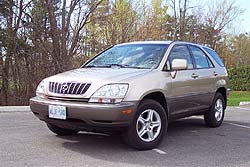 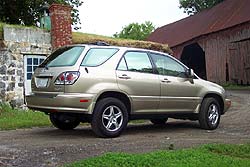 2002 Lexus RX300; photos by Grant Yoxon. Click image to enlarge |
A hybrid version, dubbed RX400h, arrived in 2006. It was powered by a version of Toyota’s Hybrid Synergy Drive gas-electric drivetrain, which paired the 3.3-litre V6 with a motor-generator under the hood, plus a second motor-generator at the rear wheels. The result is a truck that’s has more power than its non-hybrid counterpart.
Reliability has been strong for the most part, but there have been a couple of hiccups.
One is a problem with the brake boosters in 2004 models that was pointed out in this thread at LexusOwnersClub.com. Consumer Reports backs this up.
A fair amount of attention has been paid to the idle air control valve (IACV) or idle speed control (ISC) valve, an electronic device that regulates the engine’s idle speed. It appears that most problems relating to this cause a rough idle, but in extreme cases, the car may stall out. Supposedly, cleaning this valve can fix the problem; a member at LexusOwnersClub.com posted a how-to here.
Also, several owners at LexusOwnersClub.com complain of transmission troubles in RX300s. I wasn’t able to determine exactly how prevalent this is, but again, Consumer Reports data on the RX shows poorer transmission reliability for 1999 models. Read a bit about this issue here.
Among less-serious complaints are persistent rattles from the dashboard.
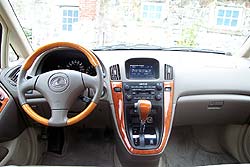 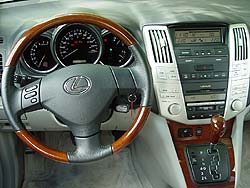 2002 Lexus RX300 (top) and 2006 Lexus RX400h; photos by Grant Yoxon (top) and Greg Wilson. Click image to enlarge |
The RX400h’s smaller sales numbers and relative newness means that reliability is hard to judge, but information on this niche model can be found at GreenHybrid.com.
Crash safety has been good: the National Highway Traffic Safety Administration (NHTSA) gave the RX300 ratings of four and five stars for driver and front-seat passenger protection in frontal impacts, and five stars for both front and rear-seat occupant protection in side impacts. The newer RX330 got five and four stars in frontal crash testing, and dual five-star ratings again in side impacts.
The Insurance Institute for Highway Safety (IIHS) gave both 1999-2003 and 2004-2007 models a “good” rating in frontal offset crash tests, but didn’t conduct side impact testing.
Anti-lock brakes and side airbags were standard on all RX models; traction control was added in 2001, and head curtain airbags appeared in 2004 models.
As is typical for Toyota and Lexus products, resale values are strong. Used values, according to Canadian Red Book, range from $10,550 for a 1999 model to a high of $39,900 for a 2008 RX350; a used RX400h will go for $35,875 (2006) to $39,725 (2007). A 2003 RX300 is worth just over $17,675, while a 2004 RX330 carries a value of $22,150.
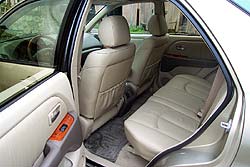 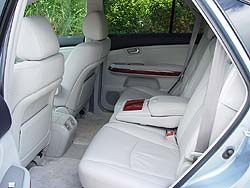 2002 Lexus RX300 (top) and 2004 Lexus RX330; photos by Grant Yoxon (top) and Greg Wilson. Click image to enlarge |
For reference, those values slot right in between those for the Mercedes-Benz ML-Class (cheaper) and a BMW X5 (more expensive); poor reliability would scare me away from either of the German models. If you want to cross-shop a used RX, look for a second-hand Acura MDX or an Infiniti FX; the Acura carries values about on par with the Lexus, while the Infiniti should be a touch cheaper, and reliability should be about the same, too. There’s also the Cadillac SRX, which comes in much less expensive, but its reliability hasn’t been great. There’s the Land Rover Discovery too, which is also cheaper, but again, has a poor reliability record, and same goes for the Volvo XC90.
The RX is definitely one of the better choices for a used high-end crossover; while it’s had a few problems throughout its model run, none of its competitors can claim to be completely trouble-free. If you’re not set on owning a Lexus, cross-shop the RX with the MDX and FX for a price you like, and you should get a reliable, comfortable vehicle out of the deal no matter which one you choose.
|
Pricing
Red Book Pricing (avg. retail) January 2009:
Online resources
The two best Lexus forums I’ve found on the web are LexusOwnersClub.com and ClubLexus.com. The first lumps the RX300 and 330 into one forum, while the second puts the RX300 into its own discussion section, while the RX330 and 350 share space. Both look like great resources, but the first seems to have more detailed threads about specific forums. Related stories on Autos
First Drive: 2007 Lexus RX 350
Manufacturer’s Website
Recalls
Transport Canada Recall Number: 1999013; Units affected: 1,363 Transport Canada Recall Number: 2006168; Units affected: 13,509 Transport Canada Recall Number: 2006021; Units affected: 398 Transport Canada Recall Number: 2004409; Units affected: 8,568
Crash test results
Used vehicle prices vary depending on factors such as general condition, odometer reading, usage history and options fitted. Always have a used vehicle checked by an experienced auto technician before you buy. For information on recalls, see Transport Canada’s web-site, www.tc.gc.ca, or the U.S. National Highway Transportation Administration (NHTSA)web-site, www.nhtsa.dot.gov. For information on vehicle service bulletins issued by the manufacturer, visit www.nhtsa.dot.gov. For information on consumer complaints about specific models, see www.lemonaidcars.com. |











